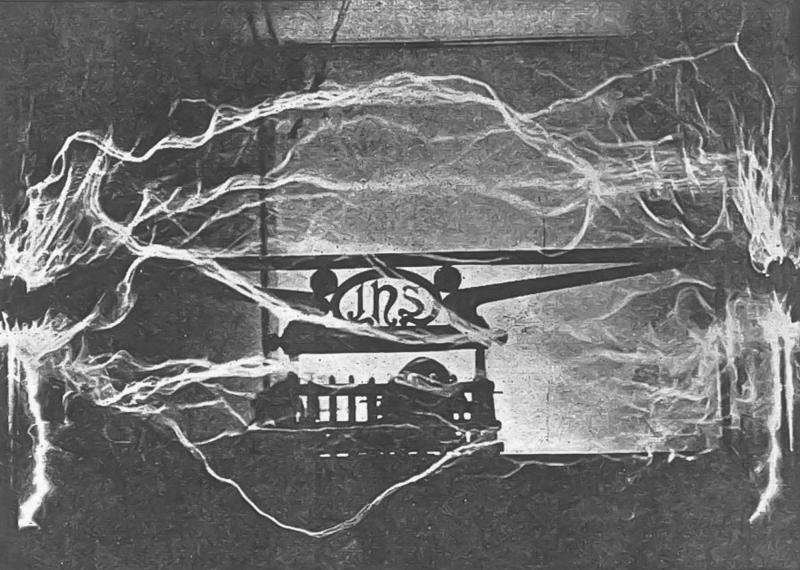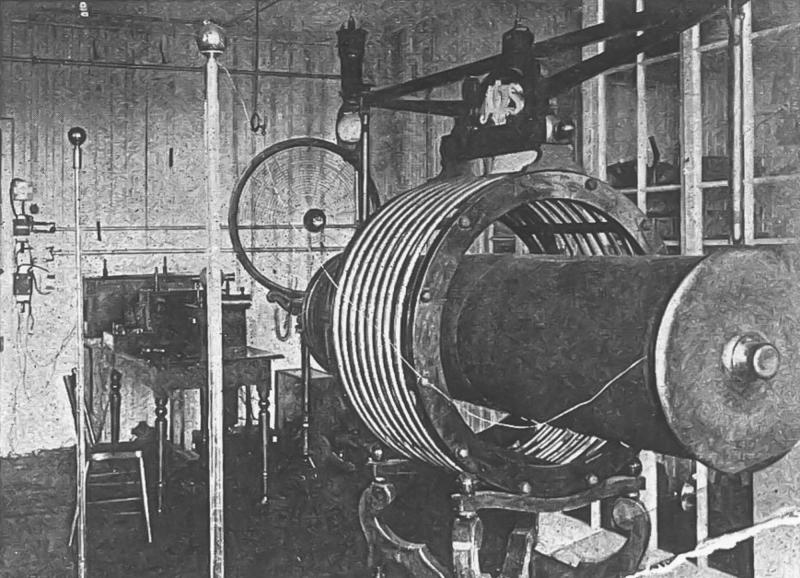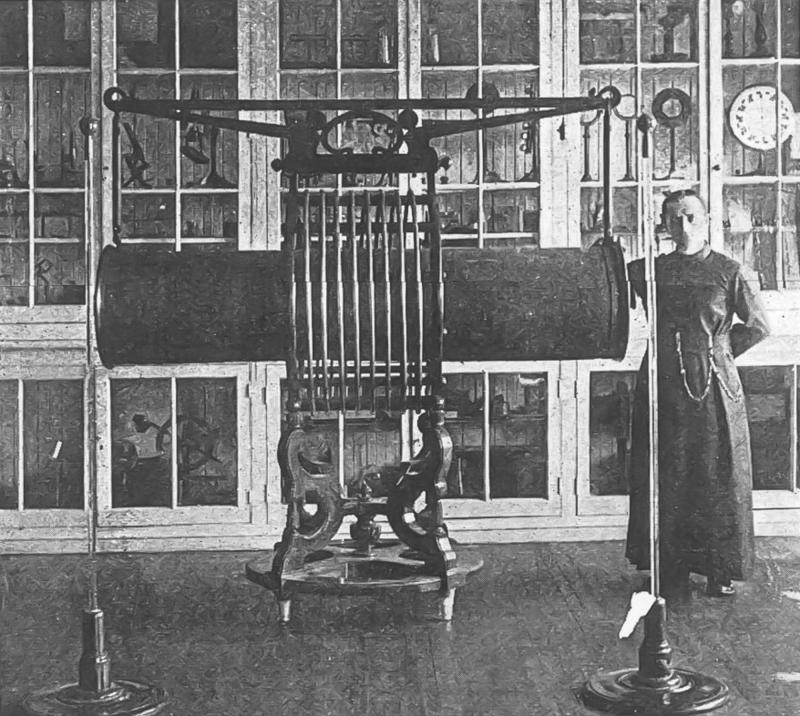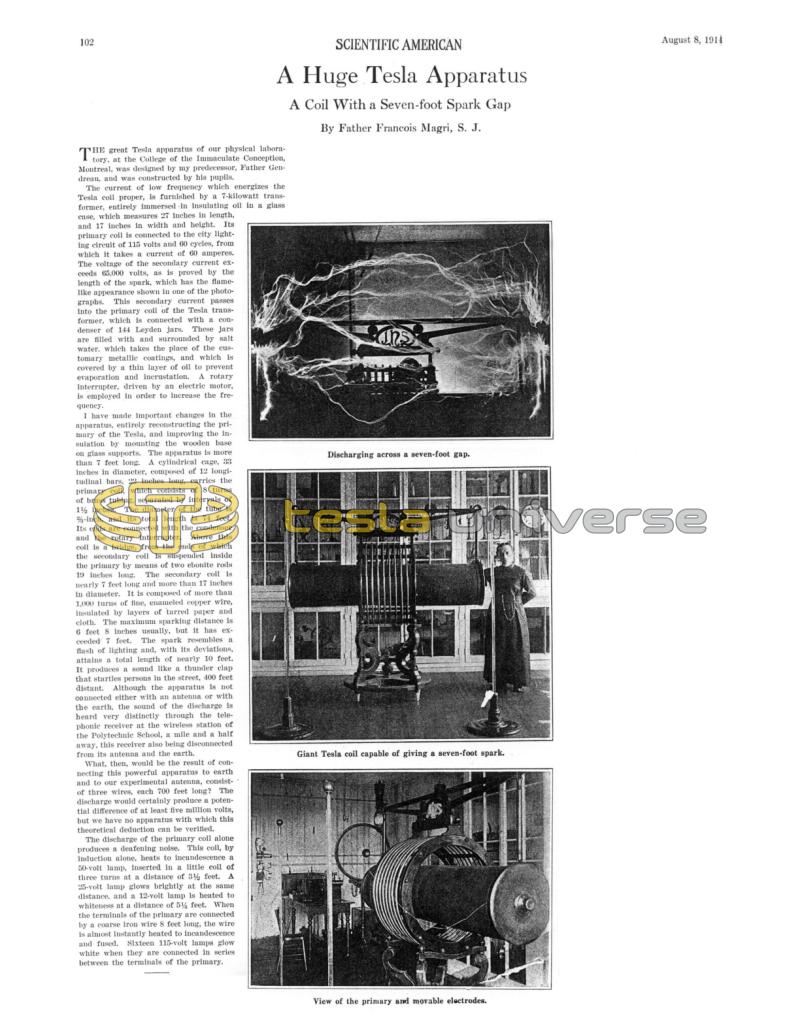
Nikola Tesla Articles
A Huge Tesla Apparatus
A Coil With a Seven-Foot Spark Gap
The great Tesla apparatus of our physical laboratory, at the College of the Immaculate Conception, Montreal, was designed by my predecessor, Father Gendreau, and was constructed by his pupils.
The current of low frequency which energizes the Tesla coil proper, is furnished by a 7-kilowatt transformer, entirely immersed in insulating oil in a glass case, which measures 27 inches in length, and 17 inches in width and height. Its primary coil is connected to the city lighting circuit of 115 volts and 60 cycles, from which it takes a current of 60 amperes. The voltage of the secondary current exceeds 65,000 volts, as is proved by the length of the spark, which has the flamelike appearance shown in one of the photographs. This secondary current passes into the primary coil of the Tesla transformer, which is connected with a condenser of 144 Leyden jars. These jars are filled with and surrounded by salt water, which takes the place of the customary metallic coatings, and which is covered by a thin layer of oil to prevent evaporation and incrustation. A rotary interrupter, driven by an electric motor, is employed in order to increase the frequency.
I have made important changes in the apparatus, entirely reconstructing the primary of the Tesla, and improving the insulation by mounting the wooden base on glass supports. The apparatus is more than 7 feet long. A cylindrical cage, 33 inches in diameter, composed of 12 longitudinal bars, 22 inches long, carries the primary coil, which consists of 8 turns of brass tubing, separated by intervals of 1½ inches. The diameter of the tube is ⅔-inch, and its total length is 74 feet. Its ends are connected with the condenser and the rotary interrupter. Above this coil is a bridge, from the ends of which the secondary coil is suspended inside the primary by means of two ebonite rods 19 inches long. The secondary coil is nearly 7 feet long and more than 17 inches in diameter. It is composed of more than 1,000 turns of fine, enameled copper wire, insulated by layers of tarred paper and cloth. The maximum sparking distance is 6 feet 8 inches usually, but it has exceeded 7 feet. The spark resembles a flash of lighting and, with its deviations, attains a total length of nearly 10 feet. It produces a sound like a thunder clap that startles persons in the street, 400 feet distant. Although the apparatus is not connected either with an antenna or with the earth, the sound of the discharge is heard very distinctly through the telephonic receiver at the wireless station of the Polytechnic School, a mile and a half away, this receiver also being disconnected from its antenna and the earth.
What, then, would be the result of connecting this powerful apparatus to earth and to our experimental antenna, consist-of three wires, each 700 feet long? The discharge would certainly produce a potential difference of at least five million volts, but we have no apparatus with which this theoretical deduction can be verified.
The discharge of the primary coil alone produces a deafening noise. This coil, by induction alone, heats to incandescence a 50-volt lamp, inserted in a little coil of three turns at a distance of 3½ feet. A 25-volt lamp glows brightly at the same distance, and a 12-volt lamp is heated to whiteness at a distance of 5¼ feet. When the terminals of the primary are connected by a coarse iron wire 8 feet long, the wire is almost instantly heated to incandescence and fused. Sixteen 115-volt lamps glow white when they are connected in series between the terminals of the primary.



